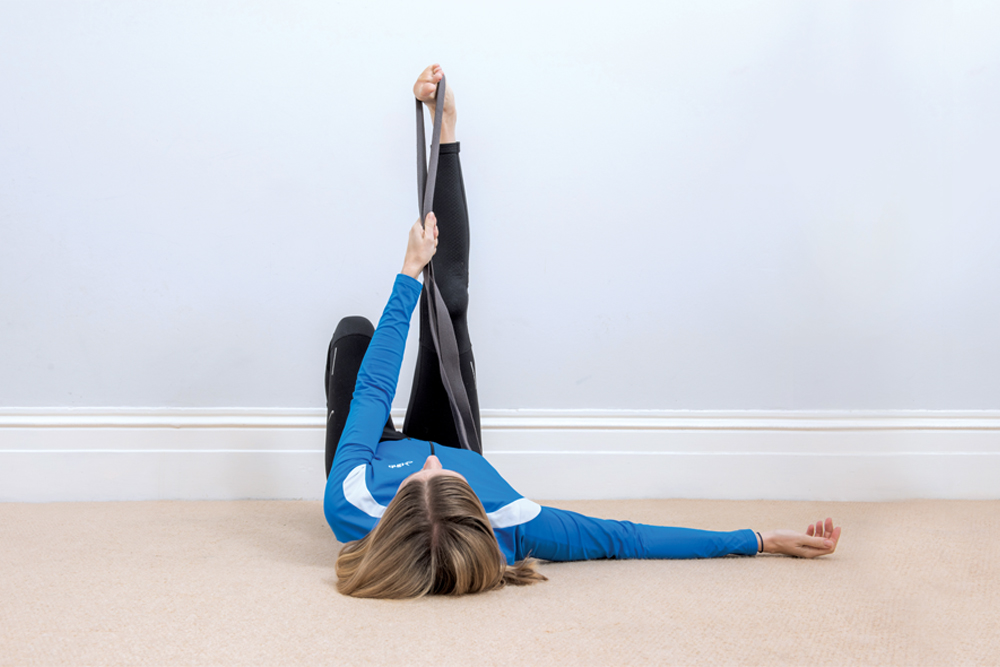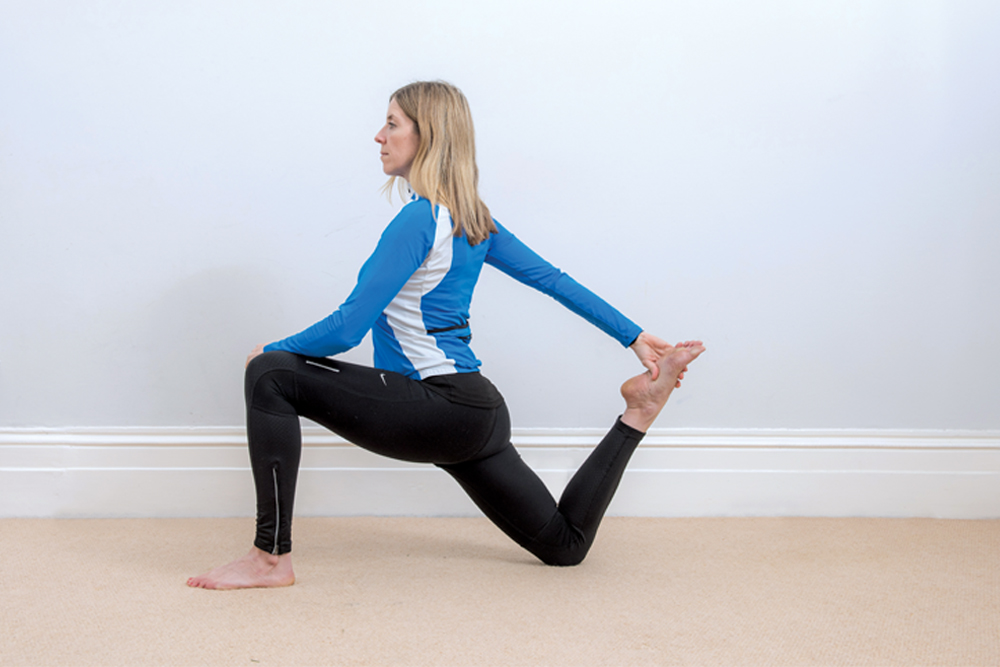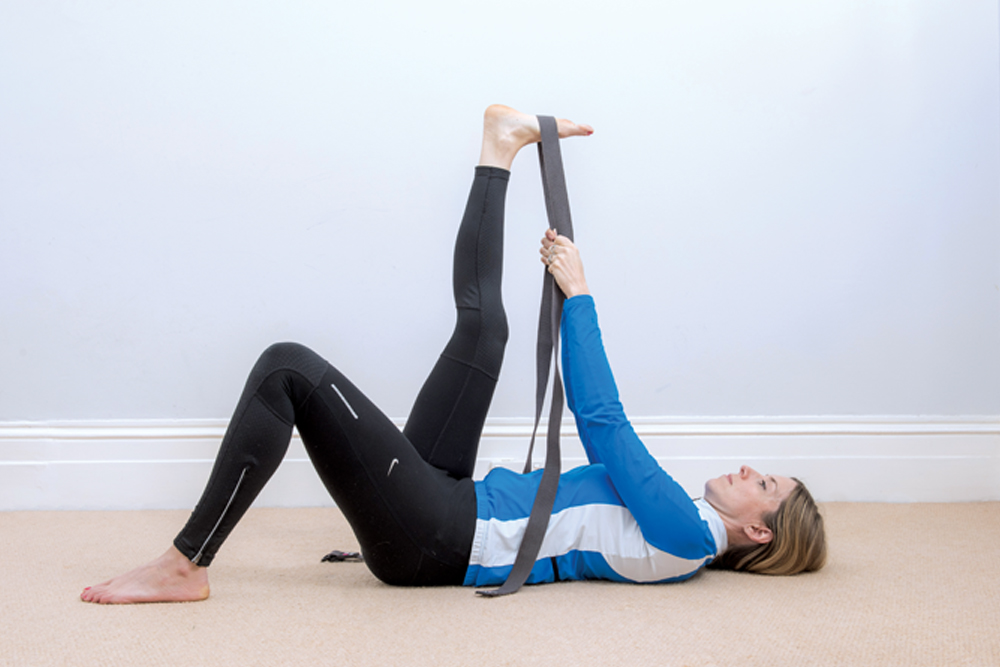Time saving stretches for cyclists (videos)
No time for stretching? Think again. One or two powerful stretches may be all you need. Lexie Williamson shows you how

For many cyclists, stretching is not at the top of the to-do list. Yet we know that just five minutes invested in lengthening tight muscles can reap big rewards in terms of injury prevention, comfort and posture.
The solution for the time-pressed or stretching-resistant cyclist is to pick just one or two stretches and make them work harder. The four stretches below achieve this aim in two ways.
>>> Quick-fire core routine for cyclists (video)
Firstly, working through the variations ensures you maintain the main stretch for the ideal 30-60 seconds. Secondly, they aim to target multiple cycling tight spots, removing the need to practise a long, time-consuming series of stretches for multiple body parts.
>>> Cycling training plans: get fitter, ride faster and go further
Many of the overuse injuries suffered by cyclists are preventable with diligent post-ride stretching. The principle is simple: to restore muscular balance to the body after hours spent on the road.
Why? Firstly, the artificially flexed cycling stance is tough on the muscles of the back, neck and shoulders, forcing them to contract for long periods. Secondly, the repetitive nature of pedalling shortens and tightens certain muscle groups such as the hip-flexors, hamstrings and quads.
Get The Leadout Newsletter
The latest race content, interviews, features, reviews and expert buying guides, direct to your inbox!
>>> Top 10 time saving nutrition tricks
Aside from the threat of injury, a little stretching can vastly improve comfort, especially around the lower and upper back while riding, and also post-ride.
Most cyclists have experienced post-exercise soreness after a hard ride (worst case scenario: an inability to walk down stairs). This is the result of micro-tears in the muscles, blood pooling and accumulated waste products.
>>> Five pre-ride breakfasts for cyclists (video)
Post-ride stretching helps to alleviate this soreness by lengthening the muscle fibres, increasing blood circulation and removing waste products, leaving the legs feeling fresher and ready to ride again.
Top four time saving stretches for cyclists
The lunge
Targets: Hip-flexors, IT band, pectorals and quads
Many cyclists neglect to stretch their hip-flexors; those hardworking cycling muscles at the front of the hip that lift the leg in every pedal stroke. But cycling really taxes this muscle group, which can become inflamed through overuse, causing pain. Low lunging is a simple way to stretch this spot.
Maintaining the position while working through the variations outlined below will ensure this group of muscles are stretched for a minimum of 60 seconds while also targeting the pecs, iliotibial (IT) band and quads. You may need to use a pad, such as a cushion, under the back knee. Avoid the final Quad Variation if it feels uncomfortable, if you have a knee injury or very tight quads.
Take one strap
Targets: Hamstrings, adductors, IT band, tensor fasciae latae, gluteals, Achilles and calf and ankle muscles
A dressing gown belt or old tie makes a great stretching aid. Collapse on the floor after a long ride. Loop it around the sole of the foot and stretch through the leg muscles, simply by moving the leg first outwards and then across the body. Press the heel up and toes down to hit the calf.
Sitting pigeon
Targets: Gluteals, IT band, piriformis, adductors, pectorals and the shoulders
Many cyclists use the yoga pose Pigeon to stretch the glutes, IT band and piriformis, all of which are prone to tightening during riding, sometimes triggering knock-on knee problems. Sitting Pigeon is simply a more accessible seated version. Control the depth of the stretch by moving the feet further forwards or back. This version also opens up the upper body into extension, reversing the flexed back position on the bike. Adjust the depth of the upper body stretch by moving the hands further away and closer (to go deeper) or further away and wider apart (to ease off).
Chair stretch
Targets: The shoulder and back muscles including latissimus dorsi, the rhomboids and trapezius
A cyclist’s back muscles are constantly engaged while cycling. A chair is a useful prop to release tension in muscles that brace the upper body over the bike for hours at a time, but a kitchen counter makes a good substitute. This simple technique gives a feeling of lengthening the spine. A word of caution, though: it can be a deceptively deep stretch so come out slowly by first drawing the abdomen in, then walking slowly towards the chair to rise up. If the hamstrings are tight, you will feel the stretch all the way down the back of the body. To specifically target the hamstrings and calves, try version two.

When to stretch: pre- or post-ride?
Current thinking is that post-ride is better. Some research suggests that deep stretching beforehand may impair performance by decreasing muscular power, endurance and balance.
However, if you have a specific problem area, such as the Achilles tendon or quads that feel chronically tight, pre-ride dynamic stretching may be beneficial.
To warm up the Achilles, dynamically perform a yoga Downward Dog and ‘walk the dog’ by pressing one heel down and bending the other leg. Switch rapidly from side to side.
To get the blood pumping to the quads, try walking up and down trying to kick your backside with your heels. The ideal time to perform static stretching is straight after cycling when the muscles are still warm, supple and responsive. That shower can wait for five minutes.

Stretch correctly
Don’t stretch cold muscles
Warm muscles are looser and more pliable, so aim to stretch as soon as you return home. If stretching later, start with some dynamic warm-up movements such as marching or gentle twisting to raise the body’s core temperature.
Don’t hold your breath
Breathe slowly and deeply through the nose to relax the muscles and aid stretching. Holding the breath causes the muscles to tighten.
Hold for 30-60 seconds
A cursory five-second stretch will make little difference. A 30-second stretch will fully restore muscles back to their resting length but stretch for longer if the area is very tight.
Stretching should not be painful
Stretch only to the point of tension (or the ‘edge’ of a stretch). Going too deep too soon will only trigger the stretch reflex (the body’s protective mechanism for overstretching). This results in muscle contraction — the opposite of what you are trying to achieve. Muscular shaking or quivering is usually a signal to ease off.
Use a prop
Stretching aids make stretching accessible to even the stiffest cyclist. Lie on your back and loop a dressing gown belt or old tie around the sole of the foot to hit the hamstrings and calves (see Take One Strap) or use it to open up the chest after hours bent over the bike. Stretch the chest muscles by placing your hands either side of a doorway and leaning the chest through the space. Release back tension with the help of a chair (see the Chair Stretch).
Lexie Williamson is the author of Yoga for Cyclists.
Lexie Williamson is the author of Yoga for Cyclists (Bloomsbury Publishing). She is a cyclist, fitness writer and Yoga Sports Science ® instructor specialising in yoga tailored for cyclists, runners and triathletes.
Lexie runs Yoga for Cyclists and Runners workshops in Surrey and Central London.

Thank you for reading 20 articles this month* Join now for unlimited access
Enjoy your first month for just £1 / $1 / €1
*Read 5 free articles per month without a subscription

Join now for unlimited access
Try first month for just £1 / $1 / €1
-
 'I was riding for the podium' - Mattias Skjelmose pulls off shock Amstel Gold Race win after reeling back Tadej Pogačar attack
'I was riding for the podium' - Mattias Skjelmose pulls off shock Amstel Gold Race win after reeling back Tadej Pogačar attackDane worked with Remco Evenepoel to set up stunning three-way finale
By Tom Davidson
-
 'All or nothing' - Mischa Bredewold wins Amstel Gold Race with stinging late attack
'All or nothing' - Mischa Bredewold wins Amstel Gold Race with stinging late attackDutchwoman takes first big Classics win of her career
By Tom Davidson